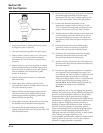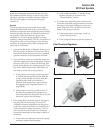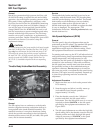
5B.15
Section 5B
EFI Fuel System
5B
Figure 5B-18. Volt Noid Light.
1. Disconnect the electrical connector from both
injectors. Plug a 12 volt noid light (part of EFI
Service Kit, see Section 2) into one connector.
2. Make sure all safety switch requirements are met.
Crank the engine and check for flashing of the
test light. Repeat test at other connector.
a. If flashing occurs, use an ohmmeter (Rx1
scale) and check the resistance of each
injector across the two terminals. Proper
resistance is 12-20
ΩΩ
ΩΩ
Ω. If injector resistance is
correct, check whether the connector and
injector terminals are making a good
connection. If the resistance is not correct,
replace the injector following steps 1-8 and
13-16 below.
b. If no flashing occurs, reattach the connectors
to both injectors. Disconnect the main harness
connector from the ECU and the connector
from the relay. Set the ohmmeter to the Rx1
scale and check the injector circuit resistance
as follows:
“24 Pin” (MSE 1.0) Plastic-Cased ECU:
Check the resistance between relay terminal
#87 and pin #16 in the main connector. Then
check the resistance between relay terminal
#87 and pin #17. Resistance should be 4-15
ΩΩ
ΩΩ
Ω
for each circuit.
“32 Pin” (MSE 1.1) Plastic-Cased ECU:
Check the resistance between relay terminal
#87 and pin #14 in the main connector. Then
check the resistance between relay terminal
#87 and pin #15. Resistance should be
4-15
ΩΩ
ΩΩ
Ω for each circuit.
Check all electrical connections, connectors, and
wiring harness leads if resistance is incorrect.
Injector leakage is very unlikely, but in those rare
instances it can be internal (past the tip of the valve
needle), or external (weeping around the injector
body). See Figure 5B-19. The loss of system pressure
from the leakage can cause hot restart problems and
longer cranking times. To check for leakage it will be
necessary to loosen or remove the blower housing
which may involve removing the engine from the unit.
Figure 5B-17. Checking Injectors.
3. Disconnect the electrical connector from an
injector and listen for a change in idle
performance (only running on one cylinder) or a
change in injector noise or vibration.
If an injector is not operating, it can indicate either a
bad injector, or a wiring/electrical connection
problem. Check as follows:
NOTE: Do not apply voltage to the fuel injector(s).
Excessive voltage will burn out the
injector(s). Do not ground the injector(s) with
the ignition “on.” Injector(s) will open/turn
on if relay is energized.
Listen Here


















